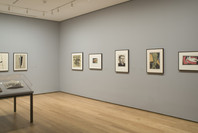This gaunt self-portrait, made one year after Germany was defeated in World War I, expresses a weariness both physical and spiritual, personal and national. Before serving in the war, Heckel had been a founding member of Die Brücke (The Bridge), one of several artist groups that pioneered the modern movement known as Expressionism, whose adherents used distorted forms and colors to heighten the emotional impact of their subjects.
Seeking to form a bridge, as the group’s name suggests, between the past and the present, Die Brücke artists revived the woodcut technique, whose rich heritage in Germany dates back to the fifteenth century. Heckel and his colleagues pushed the medium’s potential for bold, flat patterns and rough-hewn effects. In Portrait of a Man, this approach can be seen in the featureless expanses of the hair and shirt, the sharp angles of the head, and the jagged lines that model the face. The folded hands recall those of Christians praying in medieval woodcuts, a religious connotation reinforced by the portrait’s icon-like format and the stained-glass effect of black lines circumscribing brilliant swaths of green, yellow, and blue. But while those saints and believers looked toward heaven for inspiration or forgiveness, Heckel gazes weakly to the left in abject disillusionment.
Publication excerpt from MoMA Highlights: 375 Works from The Museum of Modern Art, New York (New York: The Museum of Modern Art, 2019)
This gaunt self-portrait, made one year after the end of World War I, manifests a physical and spiritual weariness that was both personal and national.
Gallery label from German Expressionism: The Graphic Impulse, March 27–July 11, 2011.
A former architecture student, Erich Heckel founded the artists' group Brücke (Bridge) in Dresden in 1905, together with Fritz Bleyl, Karl Schmidt-Rottluff, and Ernst Ludwig Kirchner. The bold coloring and sharp angularity of his portraits, nudes, bathers, and cabaret performers helped define the German Expressionist aesthetic in painting and printmaking.
During his lifetime, Heckel completed more than one thousand prints, the vast majority between 1905 and 1923. He made hundreds of etchings and lithographs, but is most acclaimed for his woodcuts, which display a radical flatness and simplification of form. He created Fränzi Reclining by sawing the woodblock into pieces, inking each part separately, and then reassembling them for printing, a jigsaw-puzzle technique derived from Edvard Munch, the Norwegian painter whose highly experimental approach to printmaking was emulated by Brücke artists. Heckel's model, twelve-year-old Fränzi, was a favorite of the Brücke members; they responded to her awkward poses, so typical of adolescence and so unlike those of conventional models. The exaggerated masklike features of her face were inspired in part by the artist's study of African sculptures at the Dresden Ethnological Museum.
After moving from Dresden to Berlin in 1911, along with other Brücke artists, Heckel turned increasingly to themes of melancholy and isolation. By 1913 the Brücke group had disbanded, and in 1915 Heckel went off to war. Portrait of a Man, a gaunt self-portrait created in the difficult months just after the war ended, manifests a psychic weariness that may be interpreted as broadly symbolic of the German people at that time. Technically, it demonstrates Heckel's ongoing eagerness to experiment with printmaking processes. The colored areas were applied to the wood with a brush rather than with the more common ink roller. The thick brushstrokes create a painterly surface that contrasts with the deliberate flatness in his earlier work.
Publication excerpt from an essay by Starr Figura, in Deborah Wye, Artists and Prints: Masterworks from The Museum of Modern Art, New York: The Museum of Modern Art, 2004, p. 56.
In Portrait of a Man, Erich Heckel inscribes the traumas of the war years and the uncertainties of the postwar period onto his own troubled face. This gaunt self-portrait, made one year after the end of World War I, embodies a physical and spiritual weariness that was both personal and national.
Heckel was a founding member of Die Brücke (the bridge), an artistic movement formed in Dresden, Germany, in 1905. Artists in that movement rejected the prevalent traditional style in favor of a new artistic expression that would form a bridge (hence the name) between the past and the present. Woodcut printing has a long history in Germany, beginning in the 15th century; Heckel and his Die Brücke colleagues revived the technique, producing an enormous number of woodcut prints.










